Hasgegawa/Greymatter 1/32 Ha-1112-M1L "Buchon"
|
KIT #: |
|
|
PRICE: |
about $40-50 or so for the Hasegawa kit |
|
DECALS: |
|
|
REVIEWER: |
Tom Cleaver |
|
NOTES: |
GreymatterConversion set £32.50
outside of Europe (about $50) - includes two
markings options. |
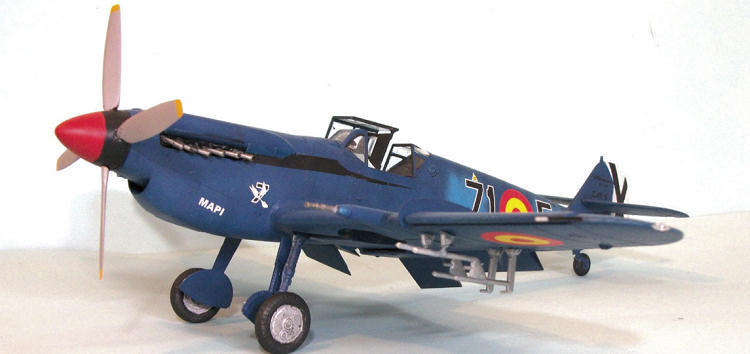
Spain
became one of the first foreign users of the Bf-109 when the Condor Legion
departed
Spain
after the civil war leaving behind their Bf‑109Es.
During the Second World War, the Spanish received a number of Bf-109Fs
and in 1942 Hispano of
Spain
negotiated an agreement with Messerschmitt to license‑manufacture 200 Bf-109G-2
fighters. The consequences of this would be lengthy, complicated, and confusing.
Hispano was supposed to receive 25 disassembled Bf-109G-2s to begin
production, but deliveries faltered as things went from bad to worse for the
Third Reich. By late 1944, Hispano had 25 Bf-109G-2 airframes and no DB‑605s.
Deciding they would never see the engines, Hispano engineers
re‑engineered the airframe to use the Hispano‑Suiza 12Z 89 engine, providing
1,300 h.p. Performance was not
appreciably better than the aging Bf-109Es.
The first of these flew on
March 2, 1945,
The Hispano‑Suiza engine was an upright V instead of an inverted V, which
demanded airframe changes. It also
rotated in the opposite direction which gave problems on takeoff since the
airfoil of the vertical fin had been designed to counteract opposite torque;
here engine and tail wanted to go the same direction. The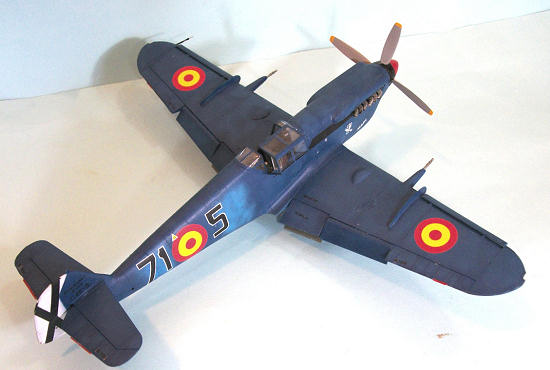 first of the 25 modified Bf-109Gs with the Hispano‑Suiza engine was flown
July 10, 1947,
designated HA‑1109‑J1L; the remainder of the 25 were completed to a similar
standard. Performance was
unsatisfactory and the Spanish Air Force (Ejercito del Aire) did not accept
them.
first of the 25 modified Bf-109Gs with the Hispano‑Suiza engine was flown
July 10, 1947,
designated HA‑1109‑J1L; the remainder of the 25 were completed to a similar
standard. Performance was
unsatisfactory and the Spanish Air Force (Ejercito del Aire) did not accept
them.
Hispano tried again with the Hispano‑Suiza 12Z 17, which was no more
powerful than the 12Z 89, but had many improvements, including fuel injection,
and was generally regarded as more satisfactory. Production of the HA‑1109‑K1L
began in 1951 and was accepted into service as the "C‑4J".
One of the HA‑1109‑K1Ls was fitted with the intended armament of a
Breda‑SAFAT 12.7 millimeter machine gun in each wing, while another was fitted
with twin Breda‑SAFAT guns in the cowling and underwing launchers for eight 80
millimeter Oerlikon rockets to test its usefulness in the close‑support role. A
third was equipped with rocket rails but no guns.
A fourth was fitted with one Hispano HS‑404 20 millimeter cannon in each
wing, plus rocket racks, which was found acceptable; most of the rest of the
HA‑1109‑J1Ls, which were then redesignated HA‑1112‑K1L by Hispano, though they
were still designated C-4J by the Air Force. Two prototypes of an unarmed
two‑seat conversion trainer were also built, with the designation HA‑1110, which
were also designated C-4J. Even with the desired armament, the air force only
used the HA‑1112‑K1L as an operational trainer.
Hispano‑Suiza abandoned production of the 12Z engine in late 1952.
In 1953 Hispano engineers turned to the British Rolls‑Royce Merlin 500‑45
engine, with 1,610 h.p. The British had earlier refused to provide Merlins as
the result of the arms embargo on
Franco
Spain,
but it was lifted in 1952.
The first Merlin conversion, designated the HA‑1109‑M1L, flew on
December 30, 1954
and demonstrated much improved performance, even with the rocket racks and wing
cannons. A large wing fence was
added to provide maneuverability even with the rails and cannons in the wing.
The Merlin‑ powered aircraft went into production is the HA‑1112‑M1L and entered
service in 1956 as the C‑4K. 171 were delivered, some being upgrades from
Hispano‑Suiza powered aircraft. The HA‑1112‑M1L, armed with either a Hispano
HS‑404 or HS‑808 cannon in each wing, had a four‑bladed Rotol propeller and a
cowling with a "deep‑breasted" appearance to accommodate the Merlin, and was
known as the "Buchon (Pigeon)". Both of the HA‑1110 two‑ seaters were re‑engined
with Merlins, and were redesignated HA‑1112‑M4L.
 The
Ifni
War:
The
Ifni
War:
The last war in which a Bf-109 derivative saw combat was The Ifni War,
also known as The Forgotten War (la Guerra Olvidada) in Spain.
The war was the result of a few hundred years of Spanish colonialism -
going back to 1475 A.D. and the colonization of the
Canary Islands
- at the expense of
Morocco.
Now independent of
France,
Morocco
determined it wanted
Spain
to return what was now known as Spanish
West Africa.
Violent demonstrations against foreign rule erupted in
Ifni
on
April 10, 1957,
followed by widespread murder of those loyal to
Spain.
In response, Franco dispatched two battalions of the Spanish Legion to El Aaiún
in June. A series of armed
incursions into Spanish
West Africa
by Moroccan insurgents and Sahrawi rebels began in October 1957, culminating in
the abortive siege of Sidi Ifni. On October 23, two villages on the outskirts of
Sidi Ifni, Goulimine and Bou Izarguen, were occupied by 1,500 Moroccan soldiers.
On
November 23, 1957,
the Spanish lines of communication were cut, and 2,000 Moroccan soldieers
stormed Spanish garrisons in and around
Ifni.
On
November 25, 1957,
a relief attempt was authorized. By
this time,
Spain
had negotiated a modernization of its armed forces with the
United States
and had begun to receive F-86 Sabres, C-47s and T-6 Texans.
The United States refused to allow Spain to use these aircraft in any
colonial wars, so the EdA was operating their old German aircraft in Spanish
West Africa, with a squadron of
CASA
2.111 “Pedro” bombers, the Spanish‑built version of the Heinkel He‑111H, a
squadron of
CASA
352 T-2 “Pava” transports, the Spanish designation of the Junkers Ju-52-3m, and
the 71 Escuadron of Ala 7 Caza de Bombardeo, equipped with the Ha-1112-M1L “Buchon”.
These aircraft had been based at
Tenerife
in the Canaries before being transferred to the mainland. Five
CASA
2.111 bombers escorted by HA-112-M1Ls bombed enemy positions, while five
C.A.S.A. 352 transports dropped a force of 75 paratroopers into the outpost.
The HA-1112-M1Ls provided close air support for the Spanish and stopped
the Moroccan advance.
On
December 3, 1957,
the Spanish Legion 6th battalion arrived, breaking the siege and retaking the
airfield. All military and civilian personnel were then evacuated overland.
Supplied from the sea by the Spanish Navy and surrounded by trenches and
forward outposts, Sidi Ifni, had 7,500 defenders by December 9, and proved
impregnable. The siege lasted until June 1958.
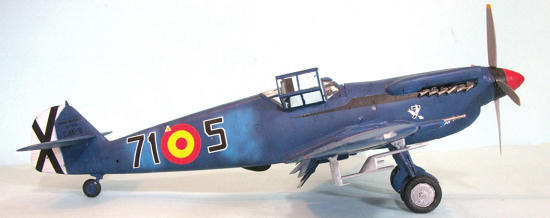 In the meantime,
Spain
and
Morocco
both concentrated their resources on Saharan theater. On January 12, a division
of the Saharan Liberation Army attacked the Spanish garrison at El Aaiún. Beaten
back by Spanish ground forces with close air support from the Buchons, the
Moroccans turned their efforts to the southeast.
The next day at Edchera, two companies of the 13th Legion battalion were
ambushed. The Legionaries drove off
attacks with mortar and small arms fire. Notable fighting was seen by the 1st
platoon, which stubbornly denied ground to the Moroccans until heavy losses
forced it to withdraw. Bloody attacks continued until nightfall, when the
Moroccans retreated.
In the meantime,
Spain
and
Morocco
both concentrated their resources on Saharan theater. On January 12, a division
of the Saharan Liberation Army attacked the Spanish garrison at El Aaiún. Beaten
back by Spanish ground forces with close air support from the Buchons, the
Moroccans turned their efforts to the southeast.
The next day at Edchera, two companies of the 13th Legion battalion were
ambushed. The Legionaries drove off
attacks with mortar and small arms fire. Notable fighting was seen by the 1st
platoon, which stubbornly denied ground to the Moroccans until heavy losses
forced it to withdraw. Bloody attacks continued until nightfall, when the
Moroccans retreated.
In February 1958, a French force of 5,000 joined the Spanish force of
9,000, supported by 150 aircraft,
launched a major offensive that dismantled the Saharan Liberation Army.
Supported by the Buchons flying close support, on February 10, the 4th,
9th, and 13th Spanish Legion battalions drove the Moroccans from Edchera while
the Spanish army at El Aaiún, in conjunction with French forces from
Fort
Gouraud,
struck the Moroccans on February 21, destroying Saharan Liberation Army
concentrations between Bir Nazaran and Ausert.
On April 2, 1958, Spain and Morocco signed the Treaty of Angra de Cintra,
in which Morocco obtained the colony of Cape Juby, between the river Draa and
the parallel 27º 40', excluding Sidi Ifni and the Spanish Sahara.
With this, the combat career of the Bf-109 finally came to a close.
Spain retained possession of Ifni until 1969, when it returned the
territory to
Morocco.
The Spanish kept control of
Western Sahara
until the 1975 Green March, when a Moroccan invasion prompted a withdrawal.
A Saharan rebel group, the Polisario Front, has fought against
Morocco
since 1976 for the independence of
Western Sahara
on behalf of the indigenous Saharawis.
Morocco
and the Polisario Front agreed in September 1991 to a UN‑negotiated cease‑fire.
In 2002,
Morocco's
present King, Mohammed VI, stated he would not “renounce an inch” of
Western Sahara.
Abundant phosphate reserves appear to be the true reason for
Morocco's
land claims. In June 2012, King
Mohammed VI offered autonomy to
Western Sahara,
with no further mention of independence and no referendum, a breach of the
United Nations cease‑fire agreement.
While 1958 saw the end of actual combat for the Bf-109 in all its
variants, one final “battle” remained to happen ten years later.
In 1967, the movie “Battle
of
Britain”
was heading into production. The
producers hoped to restage the aerial battles of that fight with actual
aircraft. However, 22 years after
the end of the Second World War, the problem was obtaining the Spitfires,
Hurricanes, Bf-109's and He-111's that were to feature in the film.
Ex-pathfinder bomber pilot Group Captain Hamish Mahaddie now specialized
in buying aircraft for film work, and his task was to track down the aircraft
needed. For the Luftwaffe aircraft,
Mahaddie negotiated with the Spanish Air Force who were still using the
HA-1112‑M1L and
CASA
2‑111D. Thirty Heinkel bombers were
loaned to United Artists by the Spanish Air Force in return for a donation by
United Artists of £1000 to the Spanish Air Force Widows Fund.
Mahaddie bought 28 HA-112-M1Ls that were in the process of being
de‑commissioned . Nearly all the
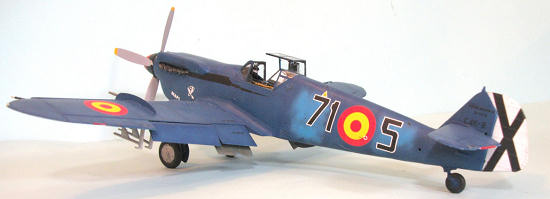 pilots
were Spanish, though four came from the Confederate Air Force in exchange for
the aircraft when filming was complete.
On
March 13, 1968,
Adolf Galland, who was military advisor for the German side, visited Tablada
airfield. Pedro Santa Cruz, an old friend from the Spanish civil war, was the
chief Spanish pilot. Someone asked
Galland how long it had been since he had flown a Bf-109, to which he answered
26 years.
Santa Cruz
climbed into the back seat of one of the two 2-seaters while Galland climbed in
front. He took off and proceeded to
give a fabulous aerial demonstration. (General Galland confirmed this legendary
tale to me when I met him at the AFA convention in 1984.)
pilots
were Spanish, though four came from the Confederate Air Force in exchange for
the aircraft when filming was complete.
On
March 13, 1968,
Adolf Galland, who was military advisor for the German side, visited Tablada
airfield. Pedro Santa Cruz, an old friend from the Spanish civil war, was the
chief Spanish pilot. Someone asked
Galland how long it had been since he had flown a Bf-109, to which he answered
26 years.
Santa Cruz
climbed into the back seat of one of the two 2-seaters while Galland climbed in
front. He took off and proceeded to
give a fabulous aerial demonstration. (General Galland confirmed this legendary
tale to me when I met him at the AFA convention in 1984.)
Today, there are some 12-14 of the HA-1112-M1Ls still flying, with others
still in existence. Two have been
modified back to original Bf-109G configuration with DB-605 engines and original
cowls. The airplane is still the
hairiest Bf-109 to fly due to the fact that the Merlin's prop and the vertical
fin want to go the same way, and it wants to “swap ends” on takeoff and when
making a power-on approach. Steve
Hinton, perhaps the best warbird pilot in the world, nearly killed himself in
one when it ground-looped on takeoff while being used in the movie “Pearl
Harbor.”
In 1974, I made the acquaintance of one of these airplanes and found out
why there are no six-footers who claim to be Bf-109 pilots: the seat is
non-adjustable and the cockpit is designed for a pilot between 5' 3" and 5' 7".
When I tried to shoehorn myself into the cockpit, it was impossible to
move the stick between my knees with my feet on the rudder pedals, not to
mention if I closed the “coffin lid” canopy I couldn't see out with any ease and
my face was 6 inches from the instrument panel.
There has been one injection-molded kit of the HA-1112-M1L, a 1/48
model made by Hobbycraft. (In 1/72, one
of Pegasus' first kits, if not kit #1, was this aircraft, but it was rather
crude. Ed) I am unaware of any other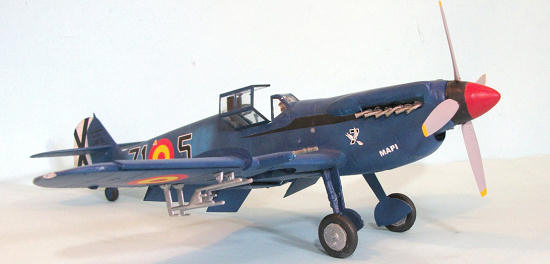 conversions, and this is certainly the only conversion in 1/32 scale.
Like the
ARBA
conversion for the S-199, it uses a solid resin nose.
Additionally, the lower center section of the fuselage is replaced
with a resin part that has the rear section of the lower cowling.
The cannon fairings are also provided in resin, as are the exhaust
stubs, the rocket launch rails and the 80mm rockets.
The prop spinner and the four propeller blades are also in resin. A
photoetch fret provides the wing fences and other panels, as well as an
instrument panel “sandwich” and seatbelts and the fins for the Oerlikon
rockets. Decals are provided
for an HA-1112-M1L in overall medium blue flown by Escuadron 71 of Ala 7 de
Caza Bombardeo, operating from Tenerife in the Canary Islands in 1958 and
likely a participant in the Ifni War, as well as an HA-1112-M1L of Escuadron
71 at Tablada Air Base in Spain in 1964 with aluminum lacquer upper surfaces
and azure blue lower surfaces, which is the airplane on display today in the
Spanish Air Force Air Museum in Madrid.
The conversion set was designed by Vincent Kermorgent, using
engineering drawings provided by Hispano Aviation, today a part of EADS.
conversions, and this is certainly the only conversion in 1/32 scale.
Like the
ARBA
conversion for the S-199, it uses a solid resin nose.
Additionally, the lower center section of the fuselage is replaced
with a resin part that has the rear section of the lower cowling.
The cannon fairings are also provided in resin, as are the exhaust
stubs, the rocket launch rails and the 80mm rockets.
The prop spinner and the four propeller blades are also in resin. A
photoetch fret provides the wing fences and other panels, as well as an
instrument panel “sandwich” and seatbelts and the fins for the Oerlikon
rockets. Decals are provided
for an HA-1112-M1L in overall medium blue flown by Escuadron 71 of Ala 7 de
Caza Bombardeo, operating from Tenerife in the Canary Islands in 1958 and
likely a participant in the Ifni War, as well as an HA-1112-M1L of Escuadron
71 at Tablada Air Base in Spain in 1964 with aluminum lacquer upper surfaces
and azure blue lower surfaces, which is the airplane on display today in the
Spanish Air Force Air Museum in Madrid.
The conversion set was designed by Vincent Kermorgent, using
engineering drawings provided by Hispano Aviation, today a part of EADS.
The conversion kit is designed to be used with the Hasegawa Bf-109G-4
or Bf-109G-6 kit.
This is an excellent conversion set that anyone could do as a first
conversion. The resin parts are
cleanly cast without mold blocks to cut off.
The instructions are clear and if you commit the radical act of
following them, you will have no problems.
I especially recommend that you do sand off the spar guides inside
the upper and lower wings of the donor kit as the instructions suggest.
You also should follow their suggestion about modifying the
attachment holes of the lower fuselage center part, which will insure a good
fit of that part.
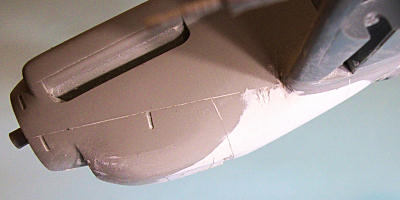
The major part, the nose piece, is designed as a drop-fit part,
requiring only that you cut the kit along panel lines to set up the
conversion.
There was one problem encountered, which may not be the case with all
kits, since I think it might be related to a molding problem.
That is that if you simply assemble the parts as instructed, the
lower cowling profile line may be too shallow, with a “flattened” look in
comparison with photos of the real thing.
I found this the case with my kit.
I applied Tamiya white putty over the area from just forward of the
vents at the rear of the lower cowling on the center part, to just behind
the opening for the waste gate.
I then sanded that down to get a smooth, convex curve along the lower
profile, and discovered (as you can see in the
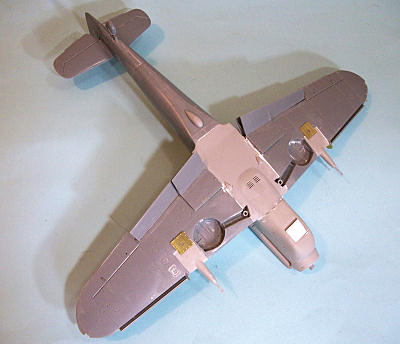 accompanying
photo) that the parts “dipped” at their join.
Once I did this, the profile was accurate.
There was no other difficulty encountered and this “difficulty”
wasn't that difficult to solve.
These kits do say “some modeling skill required.”
accompanying
photo) that the parts “dipped” at their join.
Once I did this, the profile was accurate.
There was no other difficulty encountered and this “difficulty”
wasn't that difficult to solve.
These kits do say “some modeling skill required.”
The wing cannon parts are easily attached and only need some putty to
cover over the joint seam. I
used cyanoacrylate glue to attach the wing fences and fill in the gap along
the attachment to the wing.
Past that, the entire model assembled as easily as a standard
Hasegawa kit.
The rocket rails, which come in a small bag, may be damaged in
transit. I found that mine were
bent and that the forward attachment had broken on two of them.
I dipped these in hot water to straighten them, and glued the forward
attachments back in position before removing the mold casting.
Do be certain to sand the attachments so that the rocket rails hang
straight down from the wing; they are not attached at 90 degrees to the
lower wing surface.
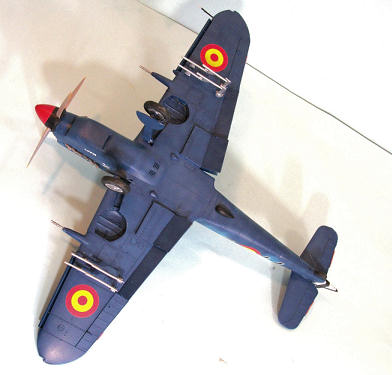 I wanted to do the blue Buchon, since my research had revealed these
airplanes were the ones that had participated in the
Ifni
War. Lynn Ritger and I had an
e-mail discussion about whether the interior of the gear doors, gear legs
and wheel wells were overall exterior blue or RLM02 grey.
We finally decided they were overall blue, as if it was a “naval
fighter.” Later I realized
these were “naval” fighters since they were based on the
Canary Islands
to provide defense against any invasion from mainland African states, so
they would be mostly operating over the ocean.
I wanted to do the blue Buchon, since my research had revealed these
airplanes were the ones that had participated in the
Ifni
War. Lynn Ritger and I had an
e-mail discussion about whether the interior of the gear doors, gear legs
and wheel wells were overall exterior blue or RLM02 grey.
We finally decided they were overall blue, as if it was a “naval
fighter.” Later I realized
these were “naval” fighters since they were based on the
Canary Islands
to provide defense against any invasion from mainland African states, so
they would be mostly operating over the ocean.
The “Peugeot Blue” was mixed using Tamiya “Royal Blue” and “Azure
Blue.” I applied it, then went
back over the model and “post shaded” with lightened paint to simulate
tropical sun-fading, which would likely have happened pretty quickly in the
western Sahara of Spanish
West Africa.
I then applied the light blue “overpaint” areas, then gave the model
a coat of Future.
The kit decals are from Fantasy Print Shop.
They come off the paper quickly and are very thin, so handle with
care. They need water on the
surface they're being applied to in order to move them into position because
they want to settle quickly.
I gave the model several coats of Xtracrylix Flat varnish to get a
“sun faded” finish. I then
attached the landing gear and
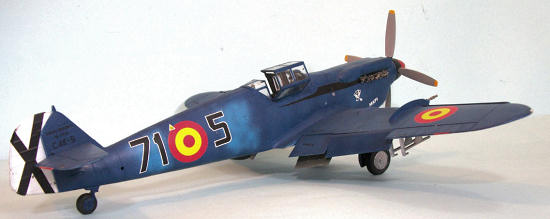 the
rocket rails. I screwed up one
of the rockets, so left them off - most photos of these airplanes show them
with the rockets unmounted anyway.
I unmasked the canopy and attached it in the open position.
I “dinged” the model with Tamiya Flat Aluminum per the photo of the
original airplane supplied in the instructions.
the
rocket rails. I screwed up one
of the rockets, so left them off - most photos of these airplanes show them
with the rockets unmounted anyway.
I unmasked the canopy and attached it in the open position.
I “dinged” the model with Tamiya Flat Aluminum per the photo of the
original airplane supplied in the instructions.
I did have problems fitting the exhaust stubs, which are a butt-fit
inside the cowling opening; after several attempts to get perfect alignment,
I concluded I would follow the John Clark Rule: “good enough is good enough,
and perfect is a pain in the posterior.”
With this kit, the late Dave Thompson's marvelous S-199 conversions,
and the Alley Cat Bf-109B, I have now done the Bf-109 in 1/32 in all its
various versions from first to last.
This will make a great display now out at Planes of Fame.
This conversion is highly recommended to those who want a similar
completeness to their 109 collection.
Tom Cleaver
July 2012
Review kit courtesy of
Greymatter Figures. Order yours
at www.greymatterfigures.com
If you would like your product reviewed fairly and fairly quickly, please contact the editor or see other details in the
Note to
Contributors.
Back to the Main Page
Back to the Reviews Index Page


 first of the 25 modified Bf-109Gs with the Hispano‑Suiza engine was flown
first of the 25 modified Bf-109Gs with the Hispano‑Suiza engine was flown
 The
The
 In the meantime,
In the meantime,  pilots
were Spanish, though four came from the Confederate Air Force in exchange for
the aircraft when filming was complete.
On
pilots
were Spanish, though four came from the Confederate Air Force in exchange for
the aircraft when filming was complete.
On  conversions, and this is certainly the only conversion in 1/32 scale.
Like the
conversions, and this is certainly the only conversion in 1/32 scale.
Like the 


